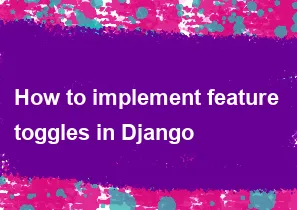How to implement feature toggles in Django

Feature toggles, also known as feature flags, are a powerful technique in software development that allows you to enable or disable certain features in your application without changing the code. This can be useful for testing new features, controlling feature releases, or handling experimental features. Here's a general guide on implementing feature toggles in a Django application:
1. Choose a Feature Toggle Library:
There are several libraries available that can help you implement feature toggles in Django. One popular choice is django-waffle. You can install it using:
bashpip install django-waffle
2. Configure Django-Waffle:
Add 'waffle' to your INSTALLED_APPS in your Django settings file.
pythonINSTALLED_APPS = [
# ...
'waffle',
]
3. Migrate the Database:
Run migrations to create the necessary database tables for django-waffle.
bashpython manage.py migrate
4. Define Feature Flags:
You can define feature flags in the Django admin interface or programmatically in your code. To define flags in code, you can use the waffle.Flag model. Here's an example:
pythonfrom waffle.models import Flag
# Create a feature flag
my_feature_flag = Flag.objects.create(name='my_feature_flag', everyone=True)
In this example, the feature flag is named 'my_feature_flag,' and it's set to be enabled for everyone. You can customize the flag's conditions based on your requirements.
5. Use Feature Toggles in Your Code:
Now that you've defined a feature flag, you can use it to conditionally enable or disable features in your code. For example:
pythonfrom waffle.models import Flag
def my_view(request):
if Flag.objects.is_enabled(request, 'my_feature_flag'):
# Feature is enabled, include feature-specific code here
return HttpResponse('Feature is enabled!')
else:
# Feature is disabled
return HttpResponse('Feature is disabled!')
6. Update Feature Flags Dynamically:
One of the benefits of using a feature toggle library is the ability to update feature flags dynamically without changing the code. You can do this through the Django admin interface or programmatically:
pythonfrom waffle.models import Flag
# Get the feature flag by name
my_feature_flag = Flag.objects.get(name='my_feature_flag')
# Enable or disable the feature flag
my_feature_flag.everyone = False # Disable for everyone
my_feature_flag.save()
This allows you to control the state of feature flags without deploying new code.
7. Clean Up:
Remember to clean up your code by removing any temporary feature-related code once the feature is fully released or deprecated.
Note:
While django-waffle is a popular choice, you can explore other feature toggle libraries like feature-flags or implement a custom solution based on your specific needs. Always check the documentation for the library you choose for the most up-to-date information and features.
-
Popular Post
- How to optimize for Google's About This Result feature for local businesses
- How to implement multi-language support in an Express.js application
- How to handle and optimize for changes in mobile search behavior
- How to handle CORS in a Node.js application
- How to use Vue.js with a UI framework (e.g., Vuetify, Element UI)
- How to configure Laravel Telescope for monitoring and profiling API requests
- How to create a command-line tool using the Commander.js library in Node.js
- How to implement code splitting in a React.js application
- How to use the AWS SDK for Node.js to interact with various AWS services
- How to use the Node.js Stream API for efficient data processing
- How to implement a cookie parser middleware in Node.js
- How to implement WebSockets for real-time communication in React
-
Latest Post
- How to implement a dynamic form with dynamic field styling based on user input in Next.js
- How to create a custom hook for handling user interactions with the browser's device motion in Next.js
- How to create a custom hook for handling user interactions with the browser's battery status in Next.js
- How to implement a dynamic form with dynamic field visibility based on user input in Next.js
- How to implement a dynamic form with real-time collaboration features in Next.js
- How to create a custom hook for handling user interactions with the browser's media devices in Next.js
- How to use the useSWRInfinite hook for paginating data with a custom loading indicator in Next.js
- How to create a custom hook for handling user interactions with the browser's network status in Next.js
- How to create a custom hook for handling user interactions with the browser's location in Next.js
- How to implement a dynamic form with multi-language support in Next.js
- How to create a custom hook for handling user interactions with the browser's ambient light sensor in Next.js
- How to use the useHover hook for creating interactive image zoom effects in Next.js